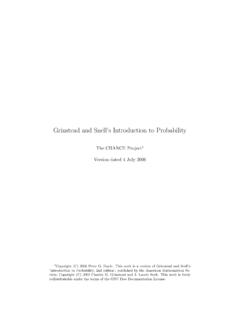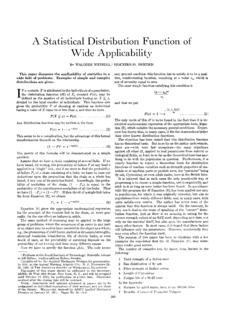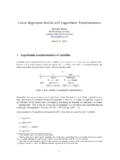Transcription of Fundamentals of Recurrent Neural Network (RNN) and Long ...
1 Published in the Elsevier journal Physica D: Nonlinear Phenomena , Volume 404, March 2020:Special Issue on Machine Learning and Dynamical SystemsFundamentals of Recurrent Neural Network (RNN)and Long Short-Term Memory (LSTM) NetworkAlex of their effectiveness in broad practical applications, LSTM networks have received a wealth of coverage in scientificjournals, technical blogs, and implementation guides. However, in most articles, the inference formulas for the LSTM networkand its parent, RNN, are stated axiomatically, while the training formulas are omitted altogether. In addition, the technique of unrolling an RNN is routinely presented without justification throughout the literature. The goal of this tutorial is to explain theessential RNN and LSTM Fundamentals in a single document. Drawing from concepts in Signal Processing, we formally derivethe canonical RNN formulation from differential equations.
2 We then propose and prove a precise statement, which yields the RNNunrolling technique. We also review the difficulties with training the standard RNN and address them by transforming the RNNinto the Vanilla LSTM 1network through a series of logical arguments. We provide all equations pertaining to the LSTM systemtogether with detailed descriptions of its constituent entities. Albeit unconventional, our choice of notation and the method forpresenting the LSTM system emphasizes ease of understanding. As part of the analysis, we identify new opportunities to enrichthe LSTM system and incorporate these extensions into the Vanilla LSTM Network , producing the most general LSTM variant todate. The target reader has already been exposed to RNNs and LSTM networks through numerous available resources and is opento an alternative pedagogical approach. A Machine Learning practitioner seeking guidance for implementing our new augmentedLSTM model in software for experimentation and research will find the insights and derivations in this treatise valuable as INTRODUCTIONS ince the original 1997 LSTM paper [21], numerous theoretical and experimental works have been published on the subjectof this type of an RNN, many of them reporting on the astounding results achieved across a wide variety of applicationdomains where data is sequential.
3 The impact of the LSTM Network has been notable in language modeling, speech-to-texttranscription, machine translation, and other applications [31]. Inspired by the impressive benchmarks reported in the literature,some readers in academic and industrial settings decide to learn about the Long Short-Term Memory Network (henceforth, theLSTM Network ) in order to gauge its applicability to their own research or practical use-case. All major open source machinelearning frameworks offer efficient, production-ready implementations of a number of RNN and LSTM Network , some practitioners, even if new to the RNN/LSTM systems, take advantage of this access and cost-effectiveness andproceed straight to development and experimentation. Others seek to understand every aspect of the operation of this elegantand effective system in greater depth. The advantage of this lengthier path is that it affords an opportunity to build a certaindegree of intuition that can prove beneficial during all phases of the process of incorporating an open source module to suitthe needs of their research effort or a business application, preparing the dataset, troubleshooting, and a common scenario, this undertaking balloons into reading numerous papers, blog posts, and implementation guides in searchof an A through Z understanding of the key principles and functions of the system, only to find out that, unfortunately, mostof the resources leave one or more of the key questions about the basics unanswered.
4 For example, the Recurrent NeuralNetwork (RNN), which is the general class of a Neural Network that is the predecessor to and includes the LSTM networkas a special case, is routinely simply stated without precedent, and unrolling is presented without justification. Moreover, thetraining equations are often omitted altogether, leaving the reader puzzled and searching for more resources, while having toreconcile disparate notation used therein. Even the most oft-cited and celebrated primers to date have fallen short of providinga comprehensive introduction. The combination of descriptions and colorful diagrams alone is not actionable, if the architecturedescription is incomplete, or if important components and formulas are absent, or if certain core concepts are left of the timeframe of this writing, a single self-contained primer that provides a clear and concise explanation of the VanillaLSTM computational cell with well-labeled and logically composed schematics that go hand-in-hand with the formulas is still1 The nickname Vanilla LSTM symbolizes this model s flexibility and generality [17].
5 1 [ ] 31 Jan 2021lacking. The present work is motivated by the conviction that a unifying reference, conveying the basic theory underlying theRNN and the LSTM Network , will benefit the Machine Learning (ML) present article is an attempt to fill in this gap, aiming to serve as the introductory text that the future students andpractitioners of RNN and LSTM Network can rely upon for learning all the basics pertaining to this rich system. With theemphasis on using a consistent and meaningful notation to explain the facts and the Fundamentals (while removing mysteryand dispelling the myths), this backgrounder is for those inquisitive researchers and practitioners who not only want to know how , but also to understand why .We focus on the RNN first, because the LSTM Network is a type of an RNN, and since the RNN is a simpler system, theintuition gained by analyzing the RNN applies to the LSTM Network as well.
6 Importantly, the canonical RNN equations, whichwe derive from differential equations, serve as the starting model that stipulates a perspicuous logical path toward ultimatelyarriving at the LSTM system reason for taking the path of deriving the canonical RNN equations from differential equations is that even thoughRNNs are expressed as difference equations, differential equations have been indispensable for modeling Neural networks andcontinue making a profound impact on solving practical data processing tasks with machine learning methods. On one hand,leveraging the established mathematical theories from differential equations in the continuous-time domain has historically ledto a better understanding of the evolution of the related difference equations, since the difference equations are obtained fromthe corresponding original differential equations through discretization of the differential operators acting on the underlyingfunctions [20, 30, 33, 54, 57, 59, 60, 61].
7 On the other hand, considering the existing deep neurally-inspired architecturesas the numerical methods for solving their respective differential equations aided by the recent advances in memory-efficientimplementations has helped to successfully stabilize very large models at lower computational costs compared to their originalversions [3, 4, 9]. Moreover, differential equations defined on the continuous time domain are a more natural fit for modelingcertain real-life scenarios than the difference equations defined over the domain of evenly-discretized time intervals [6, 51].Our primary aspiration for this document, particularly for the sections devoted to the Vanilla LSTM system and its extensions,is to fulfill all of the following requirements:1) Intuitive the notation and semantics of variables must be descriptive, explicitly and unambiguously mapping to theirrespective purposes in the ) Complete the explanations and derivations must include both the inference equations ( forward pass or normaloperation ) and the training equations ( backward pass ), and account for all components of the ) General the treatment must concern the most inclusive form of the LSTM system ( , the Vanilla LSTM ), specificallyincluding the influence of the cell s state on control nodes ( pinhole connections ).
8 4) Illustrative the description must include a complete and clearly labeled cell diagram as well as the sequence diagram,leaving nothing to imagination or guessing ( , the imperative is: strive to minimize cognitive strain, do not leaveanything as an exercise for the reader everything should be explained and made explicit).5) Modular the system must be described in such a way that the LSTM cell can be readily included as part of a pluggablearchitecture, both horizontally ( deep sequence ) and vertically ( deep representation ).6) Vector notation the equations should be expressed in the matrix and vector form; it should be straightforward to plugthe equations into a matrix software library (such asnumpy) as written, instead of having to iterate through all sources to date, one or more of the elements in the above list is not addressed2[5, 13, 14, 15, 16, 24, 26, 27, 32, 34,35, 36, 40, 42, 50, 55, 56, 66, 68, 69, 78].
9 Hence, to serve as a comprehensive introduction, the present tutorial captures allthe essential details. The practice of using a succinct vector notation and meaningful variable names as well as including theintermediate steps in formulas is designed to build intuition and make derivations easy to rest of this document is organized as follows. Section II gives a principled background behind RNN systems. ThenSection III formally arrives at RNN unrolling by proving a precise statement concerning approximating long sequences bya series of shorter, independent sub-sequences (segments). Section IV presents the RNN training mechanism based on thetechnique, known as Back Propagation Through Time , and explores the numerical difficulties, which occur when training onlong sequences. To remedy these problems, Section V methodically constructs the Vanilla LSTM cell from the canonical RNNsystem (derived in Section II) by reasoning through the ways of making RNN more robust.
10 Section VI provides a detailedexplanation of all aspects of the Vanilla LSTM cell. Even though this section is intended to be self-contained, familiaritywith the material covered in the preceding sections will be beneficial. The Augmented LSTM system, which embellishes theVanilla LSTM system with the new computational components, identified as part of the exercise of transforming the RNN tothe LSTM Network , is presented in Section VII. Section VIII summarizes the covered topics and proposes future article co-authored by one of the LSTM inventors provides a self-contained summary of the embodiment of an RNN, though not at an introductorylevel [17].2II. THEROOTS OFRNNIn this section, we will derive the Recurrent Neural Network (RNN) from differential equations [60, 61]. Let~s(t)be the valueof thed-dimensional state signal vector and consider the general nonlinear first-order non-homogeneous ordinary differentialequation, which describes the evolution of the state signal as a function of time,t:d~s(t)dt=~f(t) +~ (1)where~f(t)is ad-dimensional vector-valued function of time,t R+, and~ is a constantd-dimensional canonical form of~f(t)is:~f(t) =~h(~s(t),~x(t))(2)where~x(t)is thed-dimensional input signal vector and~h(~s(t),~x(t))is a vector-valued function of vector-valued resulting system,d~s(t)dt=~h(~s(t),~x(t)) +~ (3)comes up in many situations in physics, chemistry, biology, and engineering [65, 72].
![arXiv:0706.3639v1 [cs.AI] 25 Jun 2007](/cache/preview/4/1/3/9/3/1/4/b/thumb-4139314b93ef86b7b4c2d05ebcc88e46.jpg)

![arXiv:1301.3781v3 [cs.CL] 7 Sep 2013](/cache/preview/4/d/5/0/4/3/4/0/thumb-4d504340120163c0bdf3f4678d8d217f.jpg)
![@google.com arXiv:1609.03499v2 [cs.SD] 19 Sep 2016](/cache/preview/c/3/4/9/4/6/9/b/thumb-c349469b499107d21e221f2ac908f8b2.jpg)










